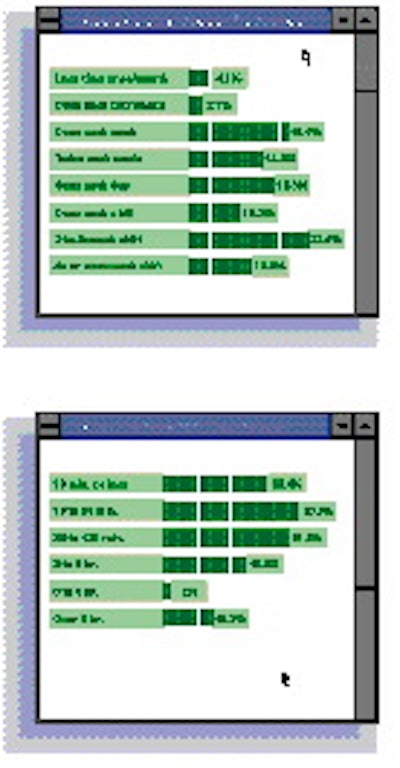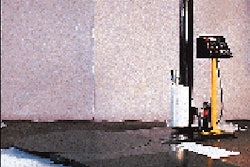Just before Pack Expo 96 last November, Packaging World commissioned a reader survey to measure packaging line changeover, to compare current experience with the previous year, and to seek comments about readers' experiences.
While the statistics show wide disparities, the comments from participants indicate far more similarity in how a large variety of companies are learning to deal with changeover. Equipment modification, better training and adding new equipment are three of the main strategies that are working to minimize the costs and the time invested in changeover at the variety of companies that employ the survey respondents.
In this report, we'll focus on answers to several questions that include the entire list of responses. In a follow-up report to be published later, we'll more closely examine the similarities and differences between respondents at large plants versus those working at smaller plants. Some additional questions will also be addressed in the second part.
The survey was conducted by personal interviews done by Frambach & Associates (Elm Grove, WI) over a random list of readers with production and engineering responsibilities. The original list was representative of the industries in proportion to their numbers on our overall circulation list, although the responses may not have been in that same proportion.
Numbers of changeovers
Based on the sample of responses, there is almost no uniformity in the number of changes a given packaging line must face. But that can't be any surprise since the respondents ranged from engineers with major national breweries using mostly dedicated packaging lines to industrial manufacturers where assembly and packaging is fairly manual.
This variety can be seen in Chart 1. Of eight responses to the question of changeover frequency, the most frequent is two to three times per shift, cited by 22.4% of all responses. However, the answers don't begin to resemble any predictable curve.
Nearly one in four answered that their average line is changed over once each week or less often. In fact, more than 6% report that changeover averages once every two weeks or less often.
On the other hand, 12.2% report changing lines four times or more each shift. By combining answers, over 44% of all respondents say that their packaging lines endure changeovers at least once each shift.
Looking at it another way, some 49% of all participants in this survey report line changeovers ranging from once each week to once each day. As we'll see in the second part of this report, there are some unique differences when we look at answers from the large plants versus the smaller ones.
Change times vary, too
Just as the frequency varies, the length of time required for packaging line changeovers covers a very broad range. Somewhat surprising to PW editors, however, is that more than one in five respondents report that some lines can be changed over in 10 minutes or less (Chart 2). At the same time, over 10% acknowledge that their plants have line changeovers that will take more than eight hours! This totals nearly one-third of responses at the two extremes of the time scale.
Somewhat more comforting is that 51% of all responses said that changeover times run from 10 minutes to two hours. In fact, the most frequent response (26.5%) was 10 to 30 minutes. That was closely followed by those in the half-hour to two-hour range (24.5%). Even within that range, most answers fell in the time period of 45 to 60 minutes.
Naturally, a large number of respondents said that changeover times vary. Many participants in the survey identified changeover times for more than one line. When pressed, the respondents often said that times would vary between two different ranges. Interviewers did not try to quantify the numbers of lines at each location that would fall in each time range.
Workers also vary
Given the disparate nature of the packaging lines, it's not unexpected that there's little uniformity in the number of workers that are involved in making changeovers to a packaging line. This will be even more important when we look at responses in large versus smaller plants.
Two workers is the median number involved in all line changeovers, say 35.4% of all respondents (Chart 3). By adding lines that are changed over with three workers, we find that one-half of all respondents claim two or three workers are responsible.
Still, some 27.1% of all responses said a single worker was responsible for line changeover. At the other extreme, nearly a quarter, 22.9%, said their changeover crew numbered four or more. That answer masks a wide range, too. Some respondents explained that their crews ranged up to 11 workers.
Identifying the crews
Based on these first three responses, the results give a general idea of how long line changeovers take, how frequently they're required and how many workers are involved. To follow up on that last question, the survey asked which types of workers made up the changeover crews (Chart 4).
Of the six selections, packaging machine operators were the clear winners, at 54.7% of all responses. In second place, general mechanics were cited by 26.4% of all respondents, and packaging mechanics by 9.4%.
The other three titles were rarely mentioned. Line supervisors was the title listed by 5.7% of the respondents, while maintenance supervisors and packaging engineers were mentioned by less than 2% each. What the results don't tell is whether the respondents could easily convert each company's worker titles to correspond to those we included as answers.
While machine operators were the most often mentioned title for changeover, some of the respondents told interviewers they were just beginning to train operators to be able to handle changeover. The director of production for an over-the-counter drug manufacturer told us, "The day is coming when we'll be training the machine operators to do more of the changeover. But for us, that's still in the future."
An automotive parts manufacturer's industrial engineer says its operator training is already underway. "Our set-up has to be as fast and accurate as possible. We're training our operators to do it. They need to have the tools ready, not to rely on set-up crews."
Holding the operators accountable is the answer at another company. The vice president for manufacturing at a cosmetics company says, "Our changeover is becoming shorter because we've worked on accountability with the operators. And," he adds, "we've modified some of our older equipment to make it easier to change over and adjust."
New machines are answer
The answer to improving changeover for some companies has been equipment replacement, or, in some cases, extra equipment that permits presetting before being rolled into position on a line.
The package engineering manager for a major appliance manufacturer sees new equipment as the answer in his Midwest plant. "Our current equipment has been in place for about five years, so it's to the point where it's not efficient for us to keep working at fine-tuning and adjusting," he reports. "Instead, we're evaluating replacement equipment, and we're looking for machines that can be adjusted more quickly."
That's been the experience of a major food processor, says its project engineer. "Our changeovers are shorter because our operators are more comfortable with the equipment. It's less than a year old, and the operators have been well trained." The same concept is echoed from a maker of OTC medicines. "Changeover is shorter because we have a new machine that makes it easier," says the production manager. "It's not a big advance, basically just a change from one manual [changeover] process to another shorter process."
A contract packager is reaping the value of redundant equipment. "We're using extra equipment," the maintenance engineer reports, "so that some machines can be preset for the next product before we're ready to run it."
And sometimes even extra spare parts can be a help. "We're reducing changeover times because a change in company management has meant more money available for parts and repairs. And we've improved our procedures," says the maintenance manager for a meat processor.
The operations manager for a beverage packer is even more specific. "We've purchased new equipment that lets us use bulk bottles. That way we don't have to make adjustments to the depalletizers," he says.
How many machines?
The survey asked participants how many machines in the line require attention in an average changeover (Chart 5).
Over half of all responses (57.7%) indicated that from one to four machines were involved in an average line changeover. Two to four machines was the most frequent answer. However, more than a third of the responses (33.4%) indicated that from five to ten machines required attention in an average changeover.
Looking at the numbers in another way, nearly one in four participants (24.4%) answered that an average changeover required attention to eight or more machines. When you realize that about one-half of the participants came from modest plant sizes (50 to 100 employees), those numbers seem quite high.
However, when you realize that even in some manual packaging operations, a case sealer and coder might need attention when a product packaging change is made, adjustments to the sealer and a roll-on coder would create an answer in the two to four machines category.
Finally, the survey asked about plant trends in changeover times. When asked to compare changeover times vs a year ago, not one respondent in any size plant indicated that changeover took longer. Of all respondents, 53.7% said the time was shorter. In the large plants, half of all respondents indicated shorter changeover time, the other half reported the time was about the same. Among responses from smaller plants, 57.1% reported shorter change times, 42.9% said it was about the same.
As strongly as any other results, these trends suggest that virtually every type of packaging operation-large or small, mass production or custom output-is paying special attention to changeover time. To help these production workers, this special changeover section also includes a sizable number of machines that specifically address the reduction in changeover times. And in our second part of this special survey report, we'll not only examine some of the differences between large and small plants, we'll also cover the skills that are important to changeover, the importance of quick-change to machinery purchases and the growing importance of tool-less changeover to today's plants.

























